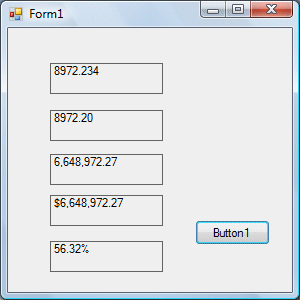The Format function in Visual Basic 2012 is a very useful formatting function. It is used to display the numeric values in various forms. There are two types of Format functions, one of them is the built-in or predefined format while another one can be defined by the users.
The syntax of the predefined Format function is
Format (n, "style argument")
where n is a number.
The list of style arguments in Visual Basic 2012 is given in Table 15.1.
| Style argument | Explanation | Example |
|---|---|---|
| General Number | To display the number without having separators between thousands. | Format(8972.234, "General Number")=8972.234 |
| Fixed | To display the number without having separators between thousands and rounds it up to two decimal places. | Format(8972.2, "Fixed")=8972.23 |
| Standard | To display the number with separators or separators between thousands and rounds it up to two decimal places. | Format(6648972.265, "Standard")= 6,648,972.27 |
| Currency | To display the number with the dollar sign in front, has separators between thousands as well as rounding it up to two decimal places. | Format(6648972.265, "Currency")= $6,648,972.27 |
| Percent | Converts the number to the percentage form and displays a % sign and rounds it up to two decimal places. | Format(0.56324, "Percent")=56.32 % |
Private Sub Button1_Click(ByVal sender As System.Object, ByVal e As System.EventArgs) Handles Button1.Click, Button5.Click, Button4.Click, Button3.Click Label1.Text = Format(8972.234, "General Number") Label2.Text = Format(8972.2, "Fixed") Label3.Text = Format(6648972.265, "Standard") Label4.Text = Format(6648972.265, "Currency") Label5.Text = Format(0.56324, "Percent") End Sub
The Output is shown in Figure 15.1

The syntax of the user-defined Format function is
Format (n, "user's format")
Although it is known as user-defined format, we still need to follows certain formatting styles. Examples of user-defined formatting style are listed in Table 15.2
| Format | Description | Output |
|---|---|---|
| Format(781234.576,"0") | Rounds to whole number without separators between thousands | 781235 |
| Format(781234.576,"0.0") | Rounds to 1 decimal place without separators between thousands | 781234.6 |
| Format(781234.576,"0.00") | Rounds to 2 decimal place without separators between thousands | 781234.58 |
| Format(781234.576,"#,##0.00") | Rounds to 2 decimal place with separators between thousands | 781,234.58 |
| Format(781234.576,"$#,##0.00") | Displays dollar sign and Rounds to 2 decimal place with separators between thousands | $781,234.58 |
| Format(0.576,"0%") | Converts to percentage form without decimal place | 58% |
| Format(0.5768,"0%") | Converts to percentage form with two decimal places | 57.68% |
Private Sub Button1_Click(ByVal sender As System.Object, ByVal e As System.EventArgs) Handles Button1.Click, Button5.Click, Button4.Click, Button3.Click Label1.Text = Format(8972.234, "0.0") Label2.Text = Format(8972.2345, "0.00") Label3.Text = Format(6648972.265, "#,##0.00") Label4.Text = Format(6648972.265, "$#,##0.00") Label5.Text = Format(0.56324, "0%") End Sub
The Output is shown below:

Copyright©2008 Dr.Liew Voon Kiong. All rights reserved |Contact|Privacy Policy